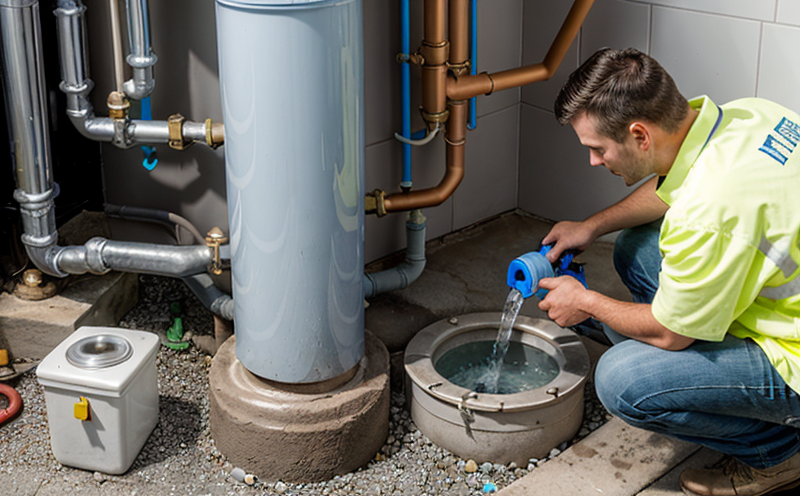ISO 4064-1 Water Meter Accuracy
The ISO 4064-1 standard specifies procedures and requirements for testing the accuracy of water meters. This international standard is crucial in ensuring that water meters provide reliable and accurate measurements, which directly impacts utility companies' billing practices and customer satisfaction.
Water meters are critical components in any plumbing or water system infrastructure. They must be tested to ensure they meet the accuracy levels specified by ISO 4064-1. This testing is essential for several reasons:
- To comply with legal requirements
- To maintain customer trust and satisfaction
- To ensure efficient resource management
- To support accurate billing practices
The accuracy of water meters can vary depending on the type of meter, its installation environment, and how well it has been maintained. Regular testing ensures that any discrepancies in performance are identified early and addressed before they affect larger systems or lead to significant costs.
ISO 4064-1 specifies two methods for testing: the test under steady flow conditions and the test under alternating flow conditions. Both methods aim to evaluate the meter's accuracy over a range of flow rates, from low to high.
The process involves calibrating the meter against a reference standard, typically a precision balance or a gravimetric system. The meter is then subjected to water flowing at various controlled rates under steady and alternating conditions. The measured volumes are compared with the expected values calculated using the ISO 4064-1 formulas.
Accurate testing of water meters ensures that they meet the required accuracy levels, typically ±2% for commercial and industrial meters, and ±5% for residential meters as per ISO 4064-1. This level of precision is critical to avoid over- or under-billing customers and to ensure efficient use of resources.
Testing water meters according to ISO 4064-1 not only helps in maintaining the integrity of utility services but also contributes to environmental sustainability by preventing unnecessary resource wastage.
Industry Applications
| Application | Description |
|---|---|
| Utility Companies | Ensure accurate billing and compliance with regulations |
| Building Owners | Verify that meters are performing within specified limits to avoid discrepancies in usage reports |
| Manufacturers of Water Meters | Validate the accuracy of their products before release into the market |
| Water Treatment Plants | Monitor the efficiency of water distribution and ensure consistent flow measurements |
The ISO 4064-1 standard is widely used in various sectors, including utility companies, building management systems, and manufacturing plants. Its application ensures that water meters function accurately across different environments and conditions.
- Utility companies benefit from accurate billing practices which can prevent disputes with customers
- Building owners gain insight into their facilities' water usage patterns to optimize consumption
- Manufacturers of water meters use this standard to ensure the quality and reliability of their products
- Water treatment plants rely on it for consistent flow monitoring and system efficiency checks
The standard's rigorous testing procedures help maintain trust between utility providers and consumers, ensuring that every drop counted accurately.
Why Choose This Test
Selecting ISO 4064-1 water meter accuracy testing offers several advantages:
- Regulatory Compliance: Ensures adherence to international standards and local regulations.
- Customer Trust: Provides accurate billing, preventing disputes and maintaining customer satisfaction.
- Environmental Impact: Prevents over- or under-use of resources, promoting sustainable practices.
- Economic Benefits: Reduces operational costs by minimizing discrepancies in usage reports and ensuring efficient resource management.
The standard's stringent requirements guarantee that water meters are tested thoroughly. This ensures not only compliance with legal requirements but also the reliability of billing processes, which is critical for maintaining customer trust. By adhering to ISO 4064-1, organizations can demonstrate their commitment to environmental stewardship and operational efficiency.
The test's comprehensive nature makes it a preferred choice for ensuring that water meters are performing at optimal levels. This not only enhances the reputation of the organization but also contributes significantly to reducing waste and optimizing resource use.
Use Cases and Application Examples
- Utility Companies: Regularly test water meters across different locations to ensure consistent performance standards. This helps in identifying any discrepancies early, allowing for timely repairs or replacements.
- Building Owners: Conduct periodic checks on the accuracy of individual meters within a building to ensure compliance with local regulations and to provide accurate usage reports to tenants.
- Manufacturers: Utilize this test during quality assurance processes to verify that their products meet or exceed industry standards before release into the market.
In addition to these, ISO 4064-1 testing is also beneficial for:
- Water Treatment Plants: Implementing it helps in monitoring water distribution efficiency and ensuring consistent flow measurements across different sectors of a plant.
- Construction Projects: Ensuring that all plumbing systems meet the required accuracy levels before final commissioning to avoid potential disputes later on.
The standard's broad applicability makes it an essential tool for any organization involved in water management or infrastructure development. By adhering to ISO 4064-1, these organizations can ensure that their plumbing and water systems are operating at peak efficiency.





